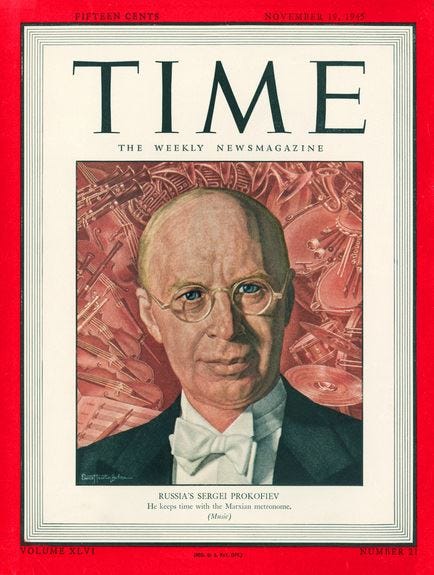
On April 27, 1891, Sergei Sergeyevich Prokofiev was born in Sontsovka, near Donetsk, Ukraine. His father, Sergei Alexeyevich, was a soil engineer and his mother, Maria (née Zhitkova), was an amateur pianist absolutely devoted to music, who spent a couple months of every year taking piano lessons in St. Petersburg or Moscow. Young Sergei was inspired by his mother’s piano playing and composed his first piece by the age of five. At the age of nine he composed his first opera, The Giant, and by the age of eleven, was studying piano and composition with the great, Reinhold Glière. In 1904, he was admitted to the St. Petersburg Conservatory, graduating in 1909 from his composition class with mediocre grades. In 1914 Prokofiev graduated from his piano class with the audacious and incredibly precocious Piano Concerto №1.
To avoid conscription into the army during WWI, he returned to the conservatory and studied organ, and it is during this time that he composed his Symphony №1 “Classical.”
And the Violin Concerto №1
1920's
The Russian Revolution had forced Prokofiev to leave Russia and after a couple of years living in the United States, he moved to Paris. Like Stravinsky before him, he achieved international acclaim with a ballet that was commissioned by Diaghilev for the Ballets Russe in Paris. His ballet, Chout, was premiered in 1921 to enormous success. Stravinsky called it, “the single piece of modern music he could listen to with pleasure.”
Prokofiev remained in Paris for the remainder of the Twenties and composed many pieces during this time, including his Piano Concerto №3.
His opera, The Love for Three Oranges
And his last ballet for Diaghilev, The Prodigal Son, which was choreographed by a young George Balanchine. This production I’m sharing is a must-see…it’s with Mikhail Baryshnikov at his best.
1930's
This decade saw Prokofiev’s return to Russia, now the Soviet Union, because of various commissions and genuine homesickness. He provided the soundtrack to the Soviet film, Lieutenant Kije.
And was commissioned to write, Romeo and Juliet, for the Kirov Ballet
And in 1936, he wrote what is perhaps his most well-known piece, Peter and the Wolf.
In 1938, he wrote one of his most inventive and unique scores for the classic film, Alexander Nevsky, directed by Sergei Eisenstein.
1940's
His piano sonatas are considered some of the most important piano pieces of the 20th century and it was during WWII that the 6th, 7th, and 8th sonatas were written. Sonata №7 was premiered by Sviatoslav Richter.
Sonata №8 was premiered by Emil Gilels.
His extraordinary music for the ballet, Cinderella, was composed in 1943.
In 1943, Prokofiev also wrote another great score to Eisenstein’s film, Ivan the Terrible, which was released in 1945.
His most popular symphony, Symphony №5, was written in the darkest moments of WWII as music of hope for a brighter day.
He wrote some of his last works for a young Mstislav Rostropovich — his Cello Sonata in 1949. Here is the world premiere recording from 1950.
And the Sinfonia Concertante (Symphony-Concerto) for cello and orchestra.
His last public appearance was for the premiere of his Symphony №7
Prokofiev died on March 5, 1953, the same day as Joseph Stalin.
